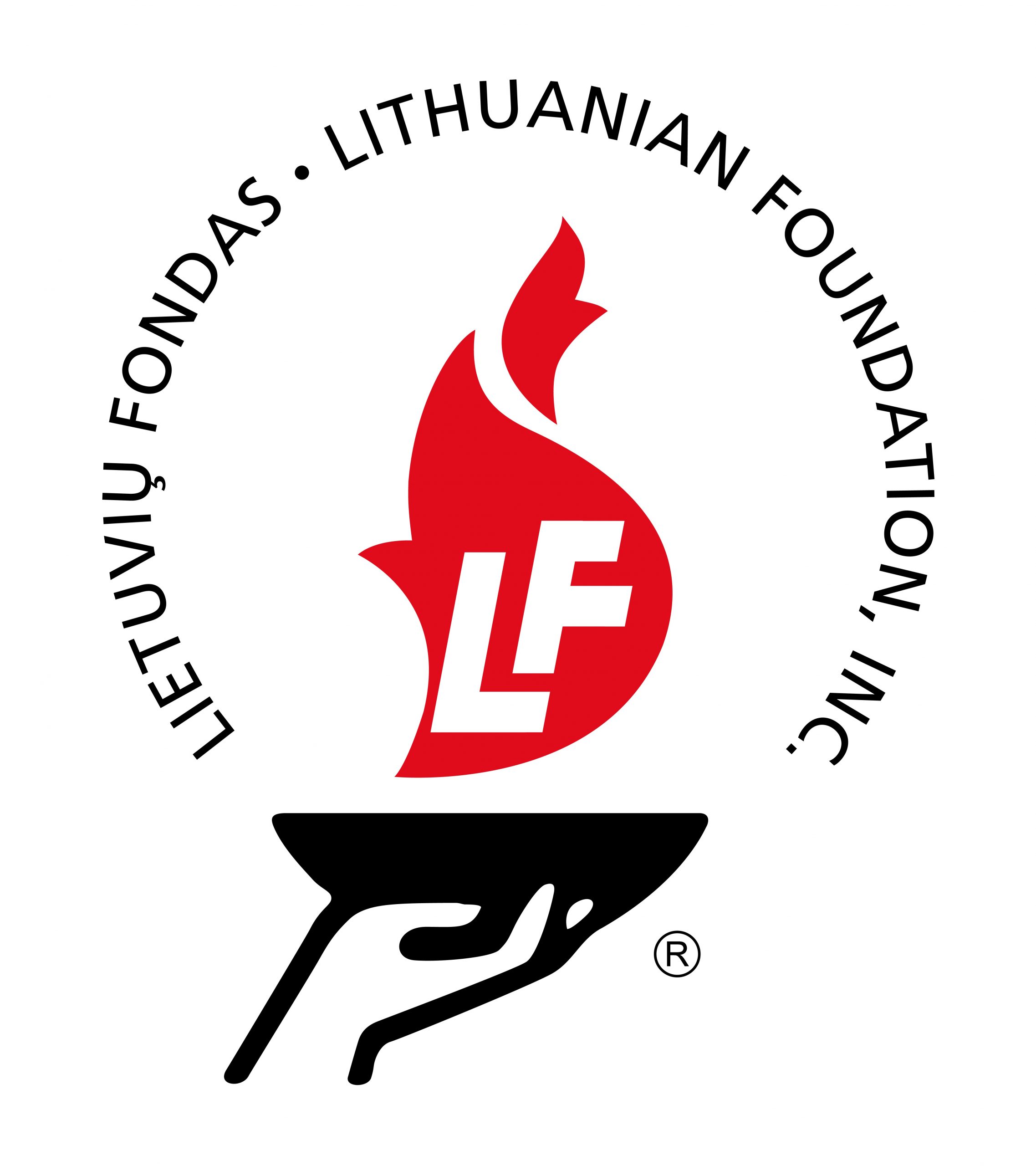Visų Šventųjų diena ir Vėlinės
Nors Lietuvoje Vėlinės švenčiamos lapkričio 2 d., dauguma mirusiuosius prisimena lapkričio 1-ąją – Visų Šventųjų dieną. Portalas lietuviai.co.uk išskiria pagrindinius skirtumus tarp Vėlinių ir Visų Šventųjų dienos:
- lapkričio 1 d. yra bažnytinė šventė, šią dieną pagerbiami šventieji, kurių paminėjimui nėra numatytos konkrečios dienos liturginiame kalendoriuje. Pirmą kartą Visų Šventųjų šventė buvo pradėta švęsti IV a. kaip Visų Kankinių diena. Pradžioje tai buvo atskirų bažnyčių, bendruomenių, bet ne visiems krikščionims privaloma šventė. Visų Šventųjų dieną į liturginį kalendorių įvedė popiežius Bonifacas IV, VIIa. pradžioje. Ši šventė skirta paminėti žmonėms, po mirties paskelbtiems šventaisiais.
- lapkričio 2 d. – Vėlinės, kai prisimenami mirusieji artimieji. 998 metais Prancūzijoje Cluny vienuolyno abatas Odilis pradėjo Vėlines švęsti lapkričio 2 d. Pamažu ši data išplito po visas bažnyčias ir vienuolynus. Vienuoliai benediktinai atnešė į Lietuvą šią tradiciją. 1311 metais Vėlinių šventė oficialiai įvesta į Romos katalikų liturgiją.
Etnologas Libertas Klimka Delfi portalui pasakoja, kad dar prieš į Lietuvą atkeliaujant krikščioniškajai tradicijai, čia panašiu metų laiku būta vietinės rudeninių sambūrių šventės, kurios esmė – padėka žemės dievybėms ir protėvių vėlėms už derlių. Kitados manyta, kad mirusiųjų vėlės globoja pasėlius, o rugio grūdas darbu sujungia kartas. Drauge su derliumi iš laukų sugrįžtančios ir vėlės; jos turi būti deramai priimamos, sušildomos, pavaišinamos ir visokeriopai pagerbiamos. Iš tokių mitinių nuostatų yra kilę ir nemažai tradicinių mūsų kaimo papročių.
Kelis pagrindiniai papročiai prisimenami lietuviai.co.uk straipsnyje: per Vėlines laukdami namuose apsilankančių vėlių, žmonės ne tik ant stalo palikdavo indus ir maistą, bet ir atvirus namų langus, duris, kad vėlės galėtų įeiti. Išėjusiesiems iš šio pasaulio kūrendavo pirtį, kad grįžusios giminės vėlės galėtų sušilti, padėdavo joms vandens, rankšluostį, maisto. Laukdavo ir atsilankančių į namus mirusių savo artimų vėlių: paklodavo lovoje baltą minkštą patalą, uždegdavo pagalvio šonuose po vieną grabnyčios žvakę, klūpodavo prie lovos laukdami ateinant mirusiojo vėlės. Jei išgirsdavo lubose ar grindyse braškant, reiškia, mirusieji atėjo. Buvo manoma, kad Vėlinių vakare vėlės gali apsilankyti nepažįstamo keleivio pavidalu. Tokie keleiviai – tai vėlės arba vėlių siųsti pasiuntiniai lankyti gyvųjų ar prašyti kokių nors malonių, kad pagelbėtų vargstantiems mirusiems. Lietuvoje, kaip ir daug kur Europoje, buvo paprotys per Vėlines pjauti aviną, o jo mėsą išdalinti elgetoms. Buvo tikima, kad elgetos turi paslaptingą ryšį su mirusiaisiais, yra lyg mirusiųjų ar gyvųjų tarpininkai. Todėl elgetas lietuviai gerbė, maitino, davė išmaldą. Liaudies įsitikinimu, šią dieną buvo pavojinga vykti į kelionę arba net eiti naktį iš namų, ginti gyvulius ir naktį juos palikti lauke, nes mirusieji gali pakenkti.
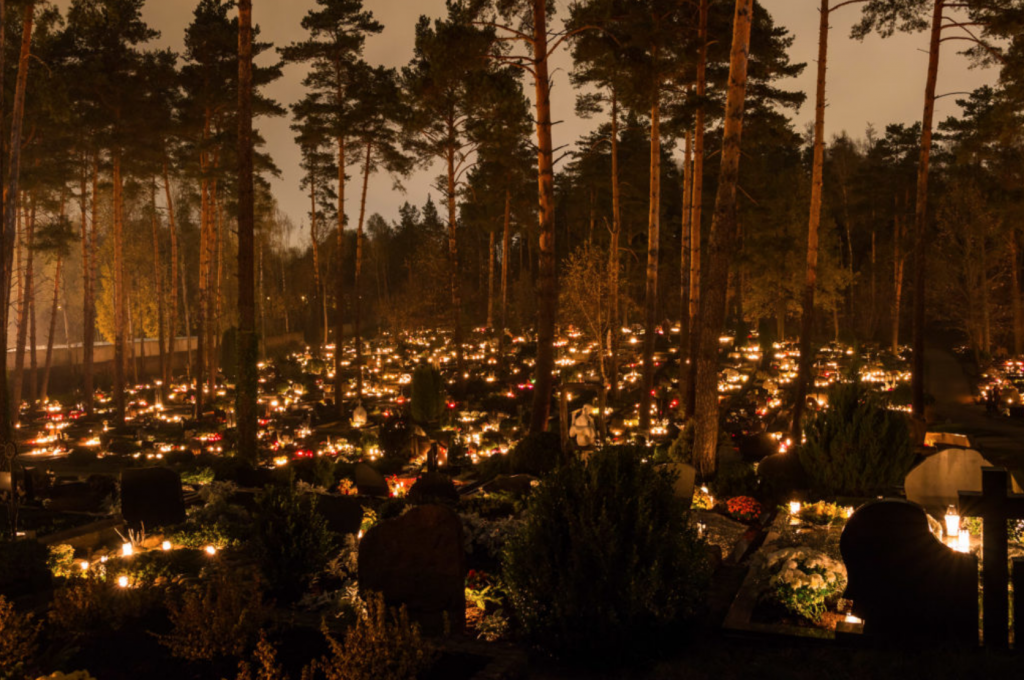
Šiandien turbūt neįsivaizduotume Vėlinių šventės be žvakių rusenimo, tačiau iki XIX amžiaus pabaigos žvakių kapinėse nedegindavo. Anksčiau ant kapo pasodindavo medį – vyrams ąžuolą, moterims – liepą ar ievą. Buvo tikima, kad į kapinių medžius bei gėles pereinančios gyventi mirusiųjų vėlės, dėl to jokios augmenijos nuo kapų neliesdavo. Kartais kapinėse kūrendavo bendrą laužą, kuriame degindavo senus nuvirtusius kryžius. Tai, kas degdavo, virsdavo šiluma ir šviesa, tarsi primindavo protėvių apeigas – seno naikinimą ir naujo gimimą. Ugnis nuo neatmenamų laikų lydėjo žmogų, ji – svarbiausias daugelio švenčių, ritualų momentas. Nuo seno manyta, kad ji nušviečia kelią amžinoje tamsoje klaidžiojančioms vėlėms, parodo jį į dangų, taip pat simbolizuoja dviejų pasaulių – gyvųjų ir mirusiųjų – amžinąjį ryšį. Anot etnologo L. Klimkos, tik nuo XIX a. antrosios pusės ėmė plisti paprotys ant kapo per Vėlines uždegti atminimo žvakelių. 1880 metais Akmens kaime (Varėnos r.) kunigas prie medinės bažnytėlės liepė supilti simbolinį kapą visiems negrįžusiems į gimtinę. Tada prismaigstė jį vaškinių žvakelių, uždegė jas, palaimino. Ir paragino žmones išsinešioti žvakeles ant artimųjų kapų kauburėlių, kad vėlelės neklaidžiotų tamsoje. Labai greit šis paprotys paplito visoje Lietuvoje.
Lietuvių šeimose yra priimta pasistengti aplankyti visus giminės mirusiųjų kapus, tie kurie yra toliau nuo namų aplankomi dar dieną prieš, jie sutvarkomi, paliekama puokštė gėlių ir uždegama žvakė.
Vėlinių vakarą šeimos, susiburia kartu, senesni žmonės mėgsta pasakoti šiurpių istorijų apie klajojančias šioje žemėje vėles be vietos, neramius vaiduoklius, be laiko išėjusiuosius iš šio pasaulio, – apie dabartines Vėlinių tradicijas rašo Voruta. Šiuolaikinį mirusiųjų pagerbimą sunku sieti tiek su protėvių kultu, tiek su religiniu mirusiųjų pagerbimu. Ne tik tikintys, bet ir netikintys savo pareiga laiko šią dieną nueiti i kapines, pagerbti artimųjų atminimą, išreikšti pagarbą tautai ir Tėvynei nusipelniusiems žmonėms. Tai yra visų vienybės, susitelkimo, rimties, ir susikaupimo diena, vykdant šventus tėvų ir protėvių priesaikus saugoti mirusiųjų atminimą, – šventės esmę apibūdina Mano Kraštas.
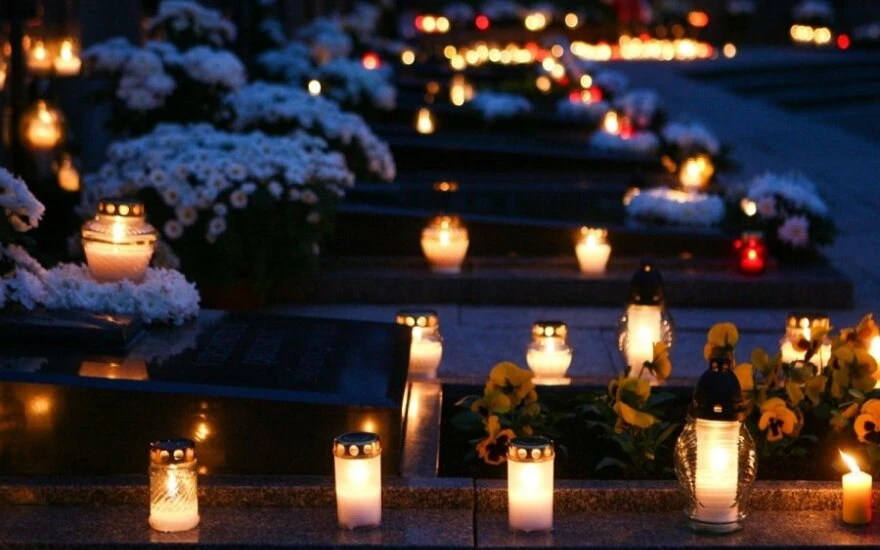
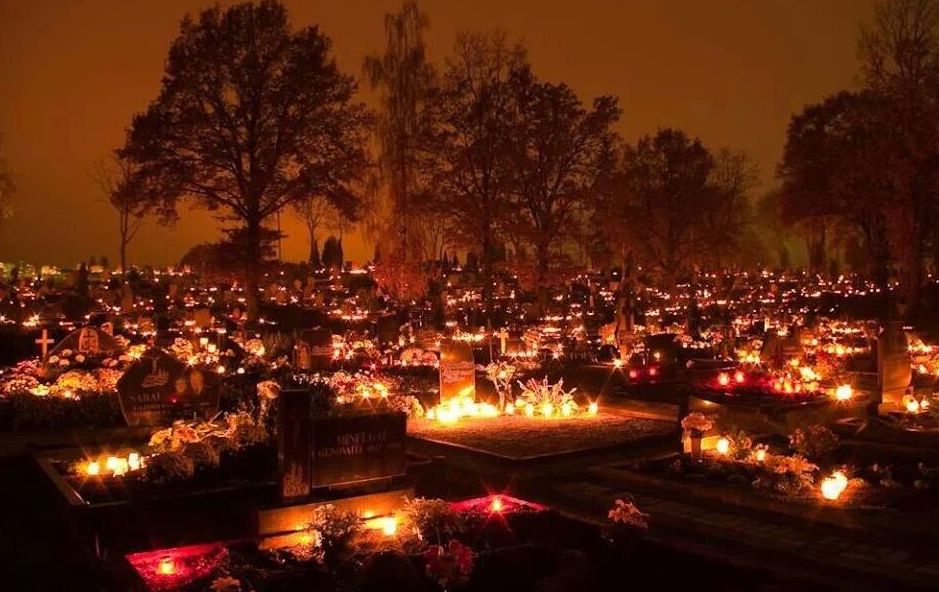
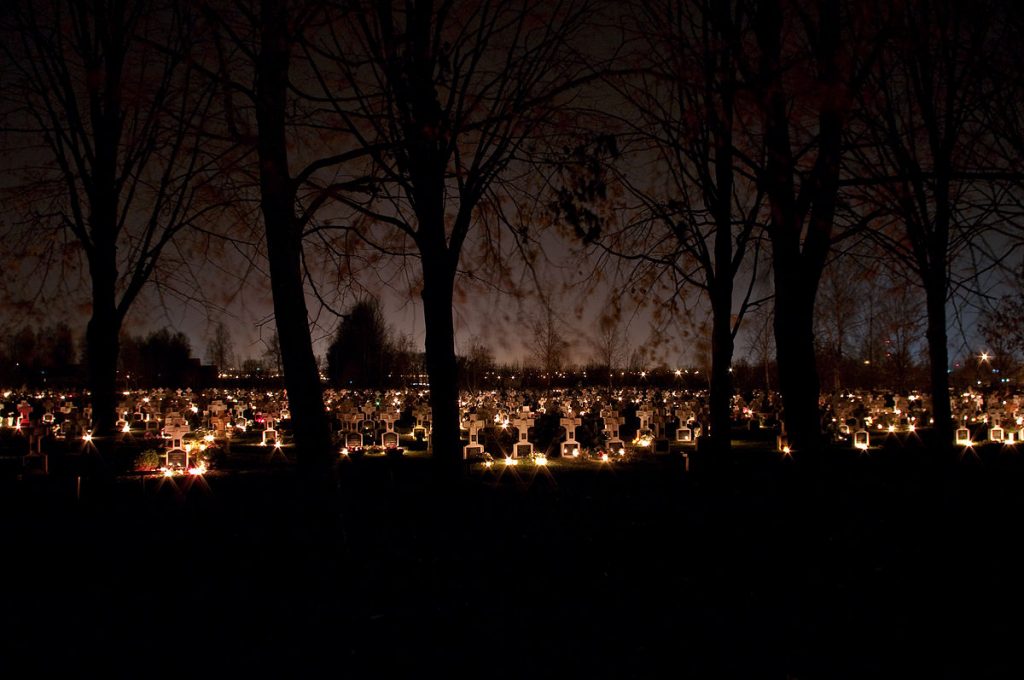
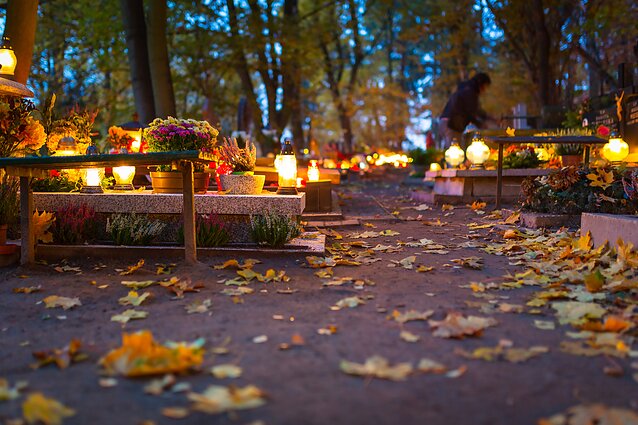
EN
Vėlinės – All Souls’ Day
Even though Lithuania’s All Souls’ Day is celebrated November 2nd, many remember the dead on November 1st- All Saints’ Day. Lietuviai.co.uk differentiate the main differences between All Souls’ Day and All Saints’ Day:
-November 1st is a church holiday, on this day we honor the saints who aren’t memorialized on any specific date in the liturgy calendar. All Saints’ Day was first celebrated in the 4th century as All Martyr’sDay. At first, it was different churches and communities, but not all Christians were required to celebrate. Pope BonifaceIV brought All Saints’ Day into the liturgy calendar at the beginning of the 7th century. This holiday is meant to commemorate the people who were proclaimed as saints after their death.
– November 2nd – All Souls’ Day is when we remember our deceased loved ones. In the year 998, Odilo, the Abbot of Cluny in France, began celebrating All Souls’ Day on November 2nd. Slowly, this date spread through all the churches and convents. The Benedictine monksbrought this tradition to Lithuania. In 1311, All Souls’ Day was officially listed in the Roman Catholic liturgy.
The ethnologist Libertas Klimka tells the story to Delfi, that even before this Christian tradition came to Lithuania, local fall celebrations, which were meant as thanks to the gods of earth and ancestral spirits for the harvest, were held around the same time of year. Alternatively, it was thought that spiritsof the dead watched over the crops and that rye planting brought generations together. Together, outdoor spirits came with the harvest; they had to be properly and warmly accepted, offered food, and honored in every way. From this mythologycomes many of our traditional countryside customs.
A few main customs are remembered on a lietuviai.co.uk article: during All Souls’ Day, while waiting at home for visiting spirits, people would leave not only plates and food on the table, but open windows and doors too, so spiritscould come in. A sauna was heated for those who have left this world, so the returning spiritscould get warm. Water, a towel, and food was also placed for them. People also waited for visits from the spirits to their home: they made the beds with soft white bedding, lit a candle by each side of the head, knelt by the bed waiting for the arriving spirits. If they heard the ceiling or floors creaking, it meant that the dead were here. It was thought, that on All Souls’ Eve, spiritscould visit in the form of an unfamiliar traveler. These strangers were spirits or their messengers, sent to visit the living or request favors to help the dead that was suffering. In Lithuania, like in a lot of other parts of Europe, there was a custom during All Souls’ Day to butcher a sheep and give out his meat to beggars. It was thought that beggars had secret connections with the dead, that they were the middlemen between the dead and the living. That’s why Lithuanians respected, fed, and gave alms for beggars. Based on folk beliefs, on this day, it was dangerous to go on a trip, to go outside of the house at night, or to try to protect the animals and leave them outside at night because the dead could harm them.
Today we probably couldn’t imagine All Souls’ Day celebration without candle lights; however, until the end of the 19th century, candles didn’t burn at cemeteries. Earlier, a tree was planted on a grave (for men an oakand women a linden or a bird cherry). It was thought that the spirits lived in the trees and flower of the cemeteries, that’s why people couldn’t touch any plants from the graves. Sometimes, there would be a communal bonfire where people burned old collapsed crosses. Those that burned, turned into warmth and light and reminded people of their ancestral rituals- death of the old and birth of the new. From a long time ago, fire accompanied a person, it was the most important moment of most celebrations and rituals. It was thought that it lights the path in an everlasting darkness that the spiritswere lost in, it shows the sky, it also symbolizes the everlasting communication between the two worlds of the living and the dead. According to ethnologist L. Klimka, only from the second half of the 19th century did the custom to light a memorializing candle start to spread. In the year of 1880, in Akmuo countryside (Varėnos r.), a priest required a symbolic grave to be constructed by a wooden church for all those who haven’t returned to the homeland. Then he stuck wax candles, lit them, and blessed the grave. He encouraged people to carry out the candles on the new graves of their loved ones, so spiritswouldn’t get lost in the dark. This custom spread very quickly throughout all of Lithuania.
In Lithuanian families, it is expected to visit all your dead relatives’ graves. Those that are farther from home are visited a day before; they are cleaned up, a bouquet of flowers is left, and a candle is lit on All Souls’ Eve.
Families come together and the elderly like to tell horror stories of the lost spirits with no place to go in this world, restless ghosts having departed, untimely, from this world- Vorutawrites about the modern All Souls’ Day traditions. It is hard to tie themodern to the religious honoring of the dead. Not only the believing, but also the non-believing, hold their duty to go to the cemetery on this day to honor the memory of loved ones, show honor for their nation’s and homeland’s deserving people. It is a day of unity, serenity, and concentration to carry out our ancestral promises to honor the memory of the dead – the meaning of this holiday is described by Mano Kraštas.
Į anglų k. vertė Eglė Urbonaitė
Šaltiniai: Delfi, lietuviai.co.uk, Mano Kraštas, Voruta.
Straipsnis publikuotas 2017d. rugsėjo 25d.
Rėmėjai
